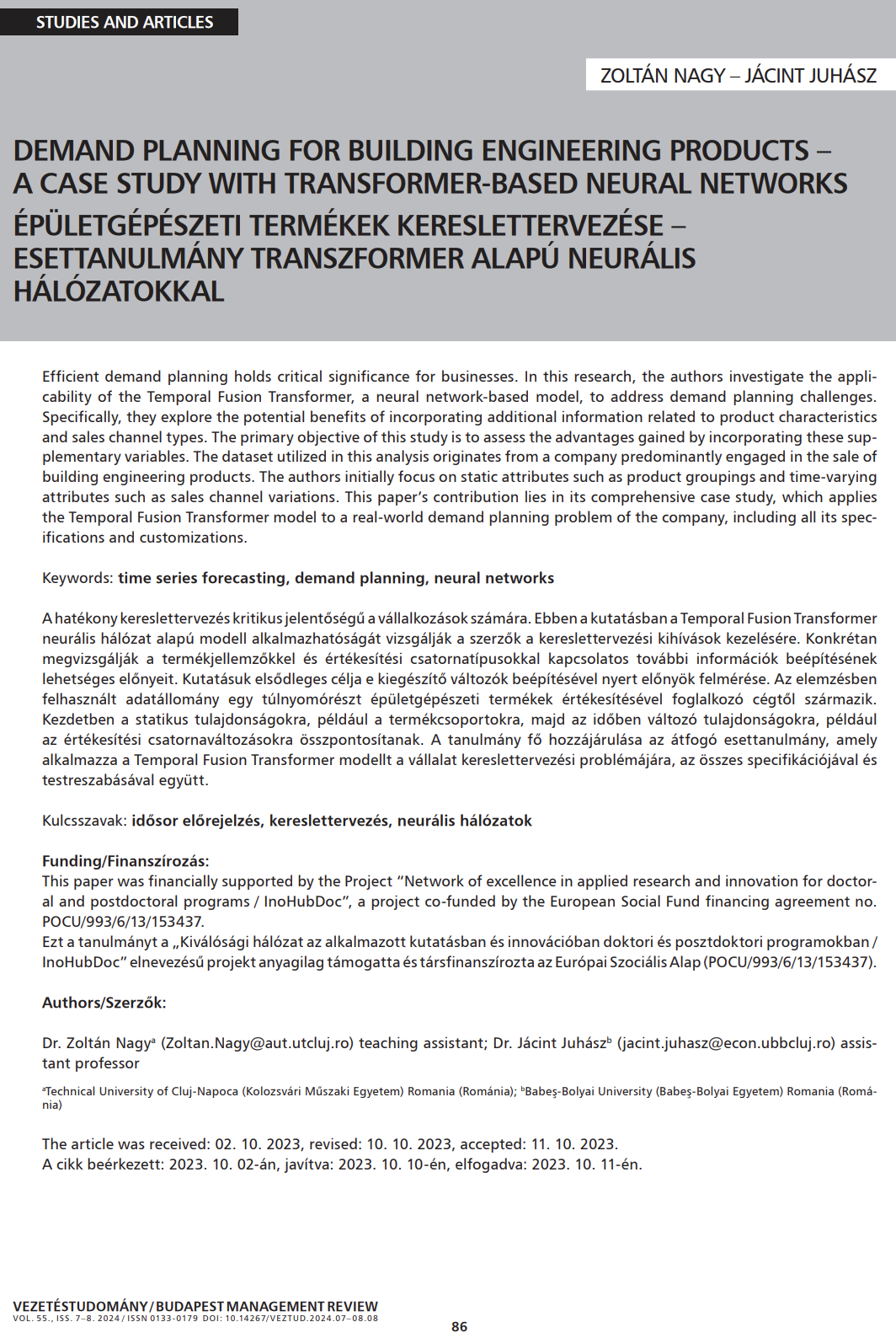Épületgépészeti termékek kereslettervezése
Esettanulmány transzformer alapú neurális hálózatokkal
DOI:
https://doi.org/10.14267/VEZTUD.2024.07-08.08Kulcsszavak:
idősor előrejelzés, kereslettervezés, neurális hálózatokAbsztrakt
A hatékony kereslettervezés kritikus jelentőségű a vállalkozások számára. Ebben a kutatásban a Temporal Fusion Transformer neurális hálózat alapú modell alkalmazhatóságát vizsgálják a szerzők a kereslettervezési kihívások kezelésére. Konkrétan megvizsgálják a termékjellemzőkkel és értékesítési csatornatípusokkal kapcsolatos további információk beépítésének lehetséges előnyeit. Kutatásuk elsődleges célja e kiegészítő változók beépítésével nyert előnyök felmérése. Az elemzésben felhasznált adatállomány egy túlnyomórészt épületgépészeti termékek értékesítésével foglalkozó cégtől származik. Kezdetben a statikus tulajdonságokra, például a termékcsoportokra, majd az időben változó tulajdonságokra, például az értékesítési csatornaváltozásokra összpontosítanak. A tanulmány fő hozzájárulása az átfogó esettanulmány, amely alkalmazza a Temporal Fusion Transformer modellt a vállalat kereslettervezési problémájára, az összes specifikációjával és testreszabásával együtt.
Letöltések
Hivatkozások
Akiba, T., Sano, S., Yanase, T., Ohta, T., & Koyama, M. (2019). Optuna: A next-generation hyperparameter optimization framework. Proceedings of the 25th ACM SIGKDD International Conference on Knowledge Discovery & Data Mining, 2623–2631. https://doi.org/10.1145/3292500.3330701
Altan, A., & Karasu, S. (2022). Crude oil time series prediction model based on LSTM network with chaotic Henry gas solubility optimization. Energy, 242, 122964. https://doi.org/10.1016/j.energy.2021.122964
Anderson, O.D. (1977). The Box-Jenkins approach to time series analysis. RAIRO-Operations Research, 11(1), 3–29. https://doi.org/10.1051/ro/1977110100031
Barros, J., Cortez, P., & Carvalho, M.S. (2021). A systematic literature review about dimensioning safety stock under uncertainties and risks in the procurement process. Operations Research Perspectives, 8, 100192. https://doi.org/10.1016/j.orp.2021.100192
Bashir, F., & Wei, H.L. (2018). Handling missing data in multivariate time series using a vector autoregressive model-imputation (VAR-IM) algorithm. Neurocomputing, 276, 23–30. https://doi.org/10.1016/j.neucom.2017.03.097
Challu, C., Olivares, K.G., Oreshkin, B.N., Ramirez, F.G., Mergenthaler-Canseco, M., & Dubrawski, A. (2023). NHITS: Neural Hierarchical Interpolation for Time Series Forecasting. Proceedings of the 37th AAAI Conference on Artificial Intelligence, AAAI 2023, 37. https://doi.org/10.1609/aaai.v37i6.25854
Chatfield, C. (1978). The Holt-winters forecasting procedure. Journal of the Royal Statistical Society: Series C (Applied Statistics), 27(3), 264–279. https://doi.org/10.2307/2347162
Chimmula, V.K.R., & Zhang, L. (2020). Time series forecasting of COVID-19 transmission in Canada using LSTM networks. Chaos, Solitons and Fractals, 135, 109864. https://doi.org/10.1016/j.chaos.2020.109864
Deloof, M. (2003). Does working capital management affect profitability of Belgian firms? Journal of Business Finance and Accounting, 30(3–4), 573-588. https://doi.org/10.1111/1468-5957.00008
El Bourakadi, D., Ramadan, H., Yahyaouy, A., & Boumhidi, J. (2023). A robust energy management approach in two-steps ahead using deep learning BiLSTM prediction model and type-2 fuzzy decision-making controller. Fuzzy Optimization and Decision Making, 22, 645-667. https://doi.org/10.1007/s10700-022-09406-y
Garcia, J.L., Martins, F.V., & Brandão, E. (2012). The Impact of Working Capital Management Upon Companies’ Profitability: Evidence from European Companies. SSRN Electronic Journal. https://doi.org/10.2139/ssrn.2165210
Gardner Jr, E.S. (1985). Exponential smoothing: The state of the art. Journal of Forecasting, 4(1), 1–28. https://doi.org/10.1002/for.3980040103
Hastie, T., & Tibshirani, R. (1987). Generalized additive models: some applications. Journal of the American Statistical Association, 82(398), 371–386. https://doi.org/10.2307/2289439
Hipel, K.W., McLeod, A.I., & Lennox, W.C. (1977). Advances in Box-Jenkins modeling: 1. Model construction. Water Resources Research, 13(3), 567–575. https://doi.org/10.1029/WR013i003p00567
Hong, T., & Wang, P. (2014). Fuzzy interaction regression for short term load forecasting. Fuzzy Optimization and Decision Making, 13, 91–103. https://doi.org/10.1007/s10700-013-9166-9
Janakiraman, G., & Roundy, R.O. (2004). Lost-sales problems with stochastic lead times: Convexity results for base-stock policies. Operations Research, 52(5), 795– 803. https://doi.org/10.1287/opre.1040.0130
Jeffery, M.M., Butler, R.J., & Malone, L.C. (2008). Determining a cost-effective customer service level. Supply Chain Management: An International Journal, 13(3), 225–232. https://doi.org/10.1108/13598540810871262
Koutsandreas, D., Spiliotis, E., Petropoulos, F., & Assimakopoulos, V. (2022). On the selection of forecasting accuracy measures. Journal of the Operational Research Society, 73(5), 937–954. https://doi.org/10.1080/01605682.2021.1892464
Lazaridis, I., & Tryfonidis, D. (2006). The relationship between working capital management and profitability of listed companies in the Athens Stock Exchange. Journal of Financial Management and Analysis, 30(76), 1-12. https://papers.ssrn.com/sol3/papers.cfm?abstract_id=931591
Lim, B., Ark, S.Ö., Loeff, N., & Pfister, T. (2021). Temporal fusion transformers for interpretable multi-horizon time series forecasting. International Journal of Forecasting, 37(4), 1748–1764. https://doi.org/10.1016/j.ijforecast.2021.03.012
Liu, A., Lu, J., & Zhang, G. (2020). Concept drift detection: dealing with missing values via fuzzy distance estimations. IEEE Transactions on Fuzzy Systems, 29(11), 3219–3233. https://doi.org/10.1109/TFUZZ.2020.3016040
Nguyen, H.D., Tran, K.P., Thomassey, S., & Hamad, M. (2021). Forecasting and Anomaly Detection approaches using LSTM and LSTM Autoencoder techniques with the applications in supply chain management. International Journal of Information Management, 57, 102282. https://doi.org/10.1016/j.ijinfomgt.2020.102282
Nobanee, H. (2017). Working Capital Management of Small Firms. SSRN Electronic Journal. https://doi.org/10.2139/ssrn.2970031
Oreshkin, B.N., Carpov, D., Chapados, N., & Bengio, Y. (2020). N-BEATS: Neural basis expansion analysis for interpretable time series forecasting. 8th International Conference on Learning Representations, ICLR 2020. https://openreview.net/attachment?id=r1ecqn4Yw-B&name=original_pdf
Salinas, D., Flunkert, V., Gasthaus, J., & Januschowski, T. (2020). DeepAR: Probabilistic forecasting with autoregressive recurrent networks. International Journal of Forecasting, 36(3), 1181–1191. https://doi.org/10.1016/J.IJFORECAST.2019.07.001
Shah, G., Fraser, J., Mandhana, V., & Verma, V. (2022). Working Capital Index Report 2022. https://www.jpmorgan.com/content/dam/jpm/treasury-services/documents/working-capital-report-2022.pdf
Taylor, S.J., & Letham, B. (2018). Forecasting at scale. The American Statistician, 72(1), 37–45. https://doi.org/10.1080/00031305.2017.1380080
Vaswani, A., Shazeer, N., Parmar, N., Uszkoreit, J., Jones, L., Gomez, A.N., Kaiser, Ł., & Polosukhin, I. (2017). Attention is all you need. Advances in Neural Information Processing Systems, 30. https://doi.org/10.48550/arXiv.1706.03762
Windaus, D., & Tebbett, S. (2021). Working Capital Report 2019/20: Creating value through working capital. https://www.pwc.com/gx/en/working-capital-management-services/assets/working-capital-report-final.pdf
Wu, B., Wang, L., & Zeng, Y.R. (2023). Interpretable tourism demand forecasting with temporal fusion transformers amid COVID-19. Applied Intelligence, 53(11), 14493–14514. https://doi.org/10.1007/s10489-022-04254-0

Downloads
Megjelent
Hogyan kell idézni
Folyóirat szám
Rovat
License
Copyright (c) 2024 Corvinus University of Budapest, publisher of Vezetéstudomány / Budapest Management Review

This work is licensed under a Creative Commons Attribution 4.0 International License.
Authors assign copyright to Vezetéstudomány / Budapest Management Review. Authors are responsible for permission to reproduce copyright material from other sources.

